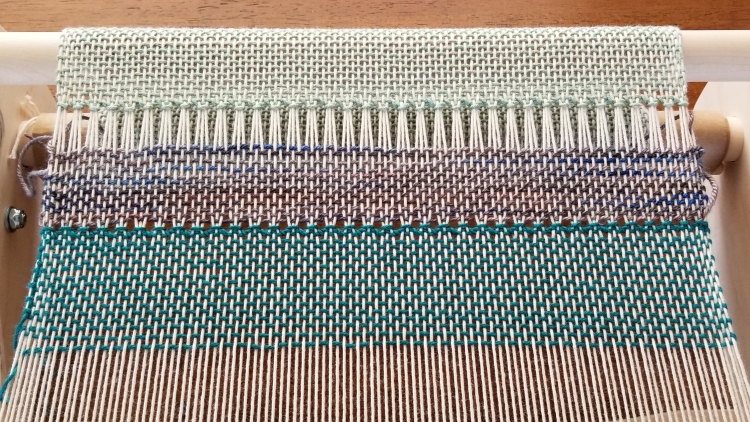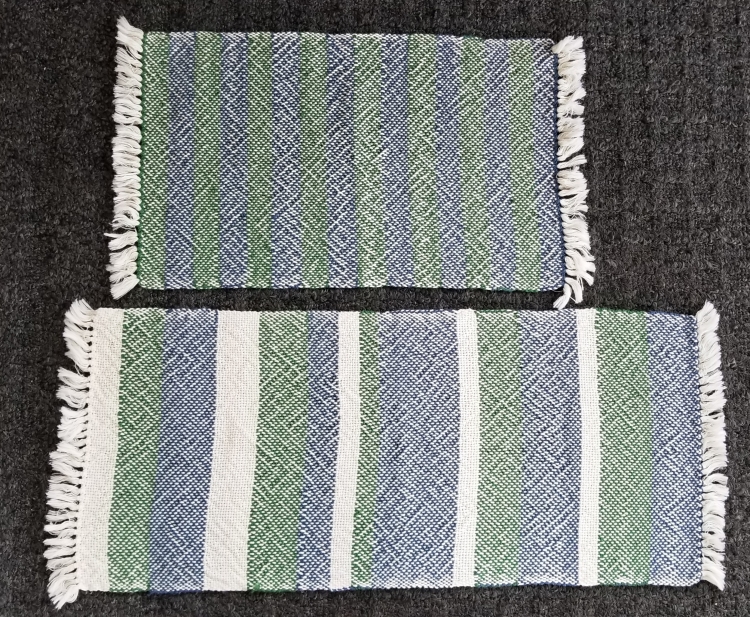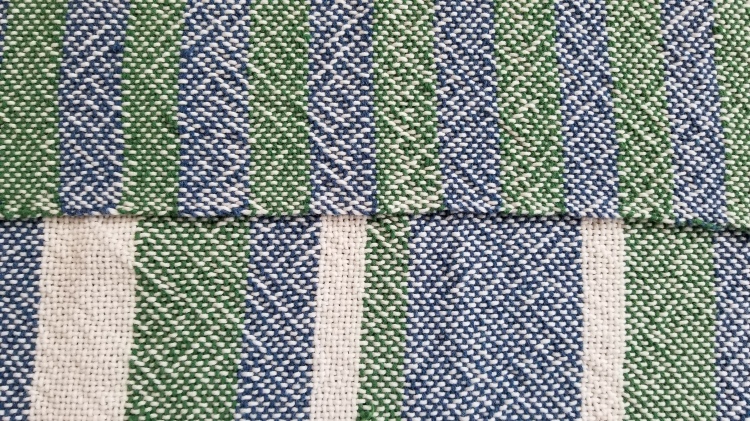For my forth towel weaving project I used some expensive organic 100% Cotton Pure yarn from Purl Soho. It is a little thicker than 8/4 cotton yarn, but thinner than Peaches & Creme yarn. I wanted to know if the more expensive yarn would make nicer towels and if it was worth the extra cost. You can see each type of cotton yarn below.

The following photo shows five colors of the Cotton Pure yarn, and one ball of Purl Soho “Lantern” cotton/linen blend. I only had two skeins of off white, so decided to use most of that for the warp. I would have a small amount of off white left for weft, and then use the colors for the rest. I decided to save the yellow cotton/linen blend for another project.

After warping the loom, the next thing to do before weaving was adding some rows of header yarn. You can see below how the warp yarn is tied on in groups to the “apron bar” at back of the loom. Weaving some header rows with a contrast yarn spreads the warp yarns out so they are evenly distributed before you begin your project.

For this project I did a hem stitch at the beginning and end of each towel while it was still on the loom. In the photos you can see the contrast yarn header rows and the hem stitch at the beginning of the towel. The weave looks loose. It relaxes after it is removed from the loom, and also the 100% cotton shrinks when it is washed, causing the fabric to be more dense.

This pattern suggests that you cut the first towel off the loom and retie the warp yarn to the apron bar for the second towel. I did that with my first set of towels, but found that wasted a lot of yarn. Instead I decided to try weaving another section of header rows after the first towel, and then go ahead and start weaving the second towel. After weaving a couple of inches of the second towel, I did the hem stitch at the beginning of the second towel. In the next photo you can see the first towel wrapped on the back beam with the end hem stitched, some contrast header rows, and the beginning of the second towel with hem stitching completed.

After using up all the warp yarn I had five towels with hem stitching on each end, and about 2.5 inches between each towel, including header rows and what would be the fringe. I removed it all from the loom, took the header rows out, and cut them apart. The photo below shows the five towels at that point.

I really like the plain white background with contrast horizonal stripes, but I did not have enough off white yarn for that. Instead, one towel is the opposite pattern, with the main weft yarn a dark color and with off white stripes. Two towels have a single contrast color for the weft yarn, and the last two are stripes of contrast colors. The fifth towel is shorter, because that is how much warp yarn was left. Maybe some day I will get the right amount of warp yarn so all the towels are the same length without wasting any yarn.
For this project I documented the completed and washed size of the towels, compared to the size they were on the loom. Between “take up” (reduction in size due to the yarn going over and under) and shrinkage from washing, the finished size was 20% smaller than what I measured out at the beginning. The next two photos show the five towels after weaving in all stray ends and washing. It looks like there is a herringbone or diagonal pattern, but actually all I did was plain weave (over under over under). Torri, my weaving mentor, tells me that twist in the yarn caused this effect.


Following you can see close up photos of the five towels in this set.


I knew that the Cotton Pure yarn was quite a bit more expensive, but when buying it I did not think about what that meant per towel. After weaving towels with three different kinds of cotton yarn, I did some calculations to compare the cost on a per towel basis. For this exercise, I assumed 160″ of warp yarn for four towels. Interestingly, the Peaches and Creme yarn that you can buy at Walmart (8 yarns per inch), and the 8/4 cotton yarn (10 yarns per inch), both came out to about $3.00 worth of yarn per towel. The organic Cotton Pure yarn from Purl Soho online costs about $12.00 (!) per towel. Quite a big difference, more than I expected. The Cotton Pure yarn towels are extremely soft and nice, and a good weight, so maybe it was worth it. They make a very nice gift, and I am worth it too, right?
The last photo shows one towel from each type of yarn.

I will be making more towels in the future. Besides being practical, they are conducive to learning new weaving techniques, such as using “pick up sticks” to make more complicated weave patterns, and “double weaving” where you can make a wider cloth. I hope everyone is not tired of reading about dish towels!


Do you notice a difference in absorbency?…. since that is my reason for using cotton dish towels
LikeLike
Yes, actually I find the peaches and creme are the most absorbent. They are the thickest.
LikeLike
These towels are beautiful. You are truly an artist. I wonder, roughly, how much time does such a project take? And as far as the cost, you are definitely worth the more expensive yarn if you feel it is better! And I would guess – it takes just as much time to weave cheaper yarn as more expensive yarn – correct? Sometimes, using something cheaper can make the process harder. In any case, love the towels.
LikeLiked by 1 person
Thank you for your comments and praise! I am not very good at keeping track of the time, and if I did, it would not be worth it. A couple of hours of setup, then maybe three more hours of weaving, plus more time with the finishing tasks. It has to be more about wanting to do it, and to learn, and liking the result. And yes, the cheaper yarn takes the same amount of time as the more expensive yarn!
LikeLiked by 1 person
Oh, I wasn’t thinking of time – money wise, just curious how long such a project takes. All our labors of love can only be truly measured with the heart. 🙂
LikeLiked by 1 person
So true!
LikeLiked by 1 person
Beautiful weaving!
LikeLiked by 1 person
Thank you!
LikeLike
So, how hard was it for you to use (I mean really use) your hand woven towel? I have difficulty wiping my hands on a new store bought towel for the first time. Yikes! Yours are so beautiful and the yarn is knit-worthy.
LikeLiked by 1 person
Haha that is kind of a problem. I try to use them for wiping clean but still wet dishes that have been hand washed. I was using one of the peaches and creme towels to dry my hands, but now the white yarn is kind of dirty looking. My sister burned one of the towels from the flame on her gas stove!! She fixed it by sewing on a hem of contrast fabric.
LikeLiked by 1 person
My solution is to ask for a new set each birthday. That way I tell myself I have a year to use the heck out of a favorite towel because another is in my future.
LikeLiked by 1 person
Excellent plan, and also why I thought making these towels was a good idea. Everyone can always use new ones!
LikeLiked by 1 person
There is something wonderful about new towels.
LikeLiked by 1 person
Really lovely weaving!
LikeLiked by 1 person
Thank you! I like making things that are both beautiful and practical.
LikeLiked by 1 person